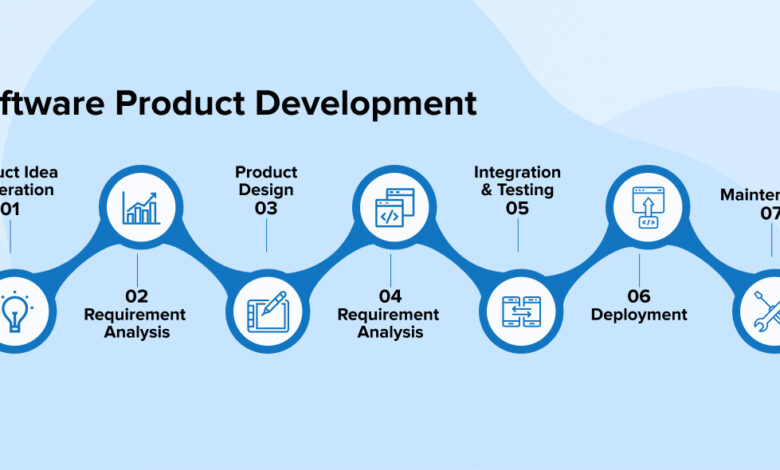Efficient Software Development Process: Key Steps Unveiled

Navigating the Software Development Process
Developing new software or upgrading existing applications should ideally be straightforward. However, a lack of a clear strategy can lead to costly delays. In today’s fast-paced technological landscape, opting out of software development isn’t an option if you want to stay competitive. This is where a structured software development process, often supported by software outsourcing, comes into play. By leveraging external expertise, you can streamline your development efforts and focus on innovation.
This guide provides insights into developing software, regardless of its type, scope, or complexity. We’ll explore the software development process and how you can optimize it to enhance project efficiency.
What Is the Software Development Process?
The software development process is a systematic sequence of stages for creating software. Typically, it includes planning, designing, coding, testing, and deployment. This process ensures that the software meets user requirements, functions correctly, and is delivered efficiently, while allowing for continuous improvement and adaptation to evolving needs.
Software Development Life Cycle Process: A StepbyStep Guide
The software development life cycle (SDLC) is a structured approach to software creation. It enables you to define your goals, leverage expertise to turn ideas into viable projects, develop the software, refine it, and release it to users. This process minimizes risks, optimizes resource use, ensures product quality, fosters collaboration with stakeholders, and helps coordinate development efforts. Let’s delve into the steps of the software development process.
- Conceptualize an Idea
The first step in software development is to generate an idea. This could be an innovative concept for your industry or a solution to a specific business problem.
Research and Strategize
Once you have an idea, it’s essential to refine it and prepare it for developers. While strategizing, consider the following:
Market Research: Identify the features your target users want and how they prefer the software to function.
Software Research: Analyze similar software to identify gaps you can fill. If you find existing software that meets your needs, consider purchasing it to save costs.
Requirements List: Compile a list of the necessary skills and technologies for development. This will guide your choice of software developers.
Feasibility Study: Assess the project’s viability in terms of budget, timeline, and technology availability.
- Design a Prototype
With research completed, communicate your findings to the software developers—whether they’re part of your internal team or an outsourced service. They will help design a prototype to visualize the software’s functionality and appearance, identifying potential issues and suggesting features.
- Develop Your Software
Once the prototype is finalized, the development team can begin building the software. Their work will follow the goals and objectives established during earlier stages.
- Test and Fix Your Software
After development, the software must be rigorously tested to ensure functionality. This may involve using Agile testing metrics to verify integration and overall performance. Internal testing and feedback from select users will help identify and resolve any bugs. Skipping this step can lead to unstable software, affecting user reception and business reputation.
- Implement Your Software
Once debugging is complete, the software can be implemented. You may choose to release it to all users or roll it out gradually. For instance, some companies opt for partial feature releases to gauge user response and resolve issues before a full launch.
- Maintenance of Operations
Even after deployment, ongoing maintenance is crucial. Regular monitoring allows for early bug fixes and ensures that the software remains aligned with technological advancements and user needs.
Variations in Software Development Processes
Software development processes can vary, often following different methodologies. The Waterfall method follows a linear approach: planning, designing, coding, testing, and deploying. Conversely, the Agile method promotes iterative development, allowing for multiple rounds of feedback and refinement.
Best Tips for a Successful Software Development Process
To enhance the likelihood of success in your software development process, consider these strategies:
Communicate Clearly: Ensure that developers fully understand your goals and have all necessary documentation.
Set Expectations: Make sure end users have a realistic understanding of the software to prevent negative reactions.
Create a Contingency Plan: Prepare a plan B to mitigate risks and minimize potential losses.
Monitor Project Quality: Regularly verify the software’s quality throughout the development stages.
Frequent Communication: Maintain open lines of communication with developers to identify issues and capitalize on opportunities early.
The software development process consists of clear steps to help you create various software solutions. It starts with an idea, evolves through refinement and collaboration with developers, and culminates in a tailored software product that meets user needs.
With this knowledge, you’re prepared to lead in technological innovation. If you lack an inhouse tech team, consider software outsourcing as a viable option. Whether you have a concept to implement or a problem to solve, partnering with experienced software developers can provide the best solutions.





